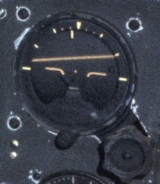
1943 Liberator crash at Whenuapai
Encyclopedia
The 1943 Liberator crash at Whenuapai was an aircraft accident in New Zealand
during World War II
. The C-87 Liberator Express
aircraft, owned by the USAAF and operated by United Airlines
, was transferring Japanese men, women and children of the Consular Corps, to exchange for Allied POWs
. On 2 August 1943, it took off from Whenuapai Aerodrome runway 04 at 2:20 am, with rain and fog conditions at minimums for departure, and quickly passed through low stratus
. Captain Herschel Laughlin’s gyro horizon had inadvertently been left caged – while the instrument displayed level flight, the aircraft entered a steepening bank to the left. The crew detected the problem in a few seconds, but as the aircraft was straightening up and levelling out, it hit the ground at about 322 km/h (200.1 mph), bounced a few times and exploded. The third bounce threw its first officer, R. John Wisda, out through the canopy; he rolled end over end about 100 metres (328.1 ft) through mud and reeds. A medic later found him trying to keep warm near a burning tyre. The major factors of the accident were the lack of a pre-flight checklist, and crew fatigue (126 flying hours in the last 26 days).
The crash killed three of the five crew (United States nationals), and eleven of the twenty-five passengers (eight Japanese and three Thai nationals). Two additional passengers died later from injuries.
The TSS Wahine took the surviving internees from Wellington to Sydney three months later.
TVNZ covered the crash during the program Secret New Zealand in 2003, and posited the accident was covered up, due to concerns of reprisals against POWs.
New Zealand
New Zealand is an island country in the south-western Pacific Ocean comprising two main landmasses and numerous smaller islands. The country is situated some east of Australia across the Tasman Sea, and roughly south of the Pacific island nations of New Caledonia, Fiji, and Tonga...
during World War II
World War II
World War II, or the Second World War , was a global conflict lasting from 1939 to 1945, involving most of the world's nations—including all of the great powers—eventually forming two opposing military alliances: the Allies and the Axis...
. The C-87 Liberator Express
C-87 Liberator Express
|-References:NotesBibliography* Andrade, John. U.S. Military Aircraft Designations and Serials since 1909. Hinckley, UK: Midland Counties Publications, 1979. ISBN 0-904597-22-9....
aircraft, owned by the USAAF and operated by United Airlines
United Airlines
United Air Lines, Inc., is the world's largest airline with 86,852 employees United Air Lines, Inc., is the world's largest airline with 86,852 employees United Air Lines, Inc., is the world's largest airline with 86,852 employees (which includes the entire holding company United Continental...
, was transferring Japanese men, women and children of the Consular Corps, to exchange for Allied POWs
Prisoner of war
A prisoner of war or enemy prisoner of war is a person, whether civilian or combatant, who is held in custody by an enemy power during or immediately after an armed conflict...
. On 2 August 1943, it took off from Whenuapai Aerodrome runway 04 at 2:20 am, with rain and fog conditions at minimums for departure, and quickly passed through low stratus
Stratus cloud
A stratus cloud is a cloud belonging to a class characterized by horizontal layering with a uniform base, as opposed to convective clouds that are as tall or taller than wide . More specifically, the term stratus is used to describe flat, hazy, featureless clouds of low altitude varying in color...
. Captain Herschel Laughlin’s gyro horizon had inadvertently been left caged – while the instrument displayed level flight, the aircraft entered a steepening bank to the left. The crew detected the problem in a few seconds, but as the aircraft was straightening up and levelling out, it hit the ground at about 322 km/h (200.1 mph), bounced a few times and exploded. The third bounce threw its first officer, R. John Wisda, out through the canopy; he rolled end over end about 100 metres (328.1 ft) through mud and reeds. A medic later found him trying to keep warm near a burning tyre. The major factors of the accident were the lack of a pre-flight checklist, and crew fatigue (126 flying hours in the last 26 days).
The crash killed three of the five crew (United States nationals), and eleven of the twenty-five passengers (eight Japanese and three Thai nationals). Two additional passengers died later from injuries.
The TSS Wahine took the surviving internees from Wellington to Sydney three months later.
TVNZ covered the crash during the program Secret New Zealand in 2003, and posited the accident was covered up, due to concerns of reprisals against POWs.

